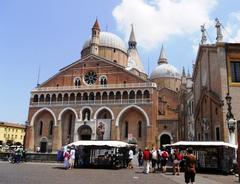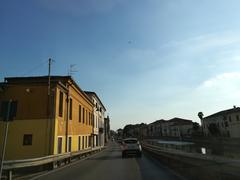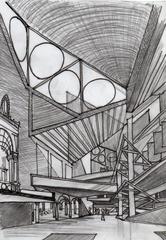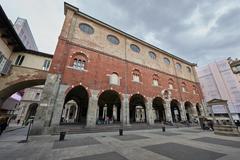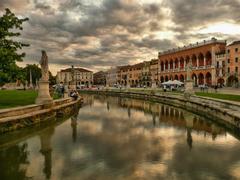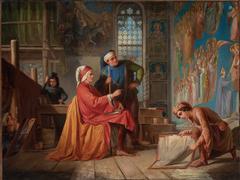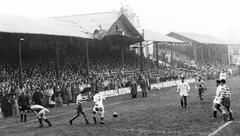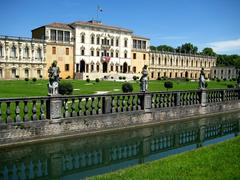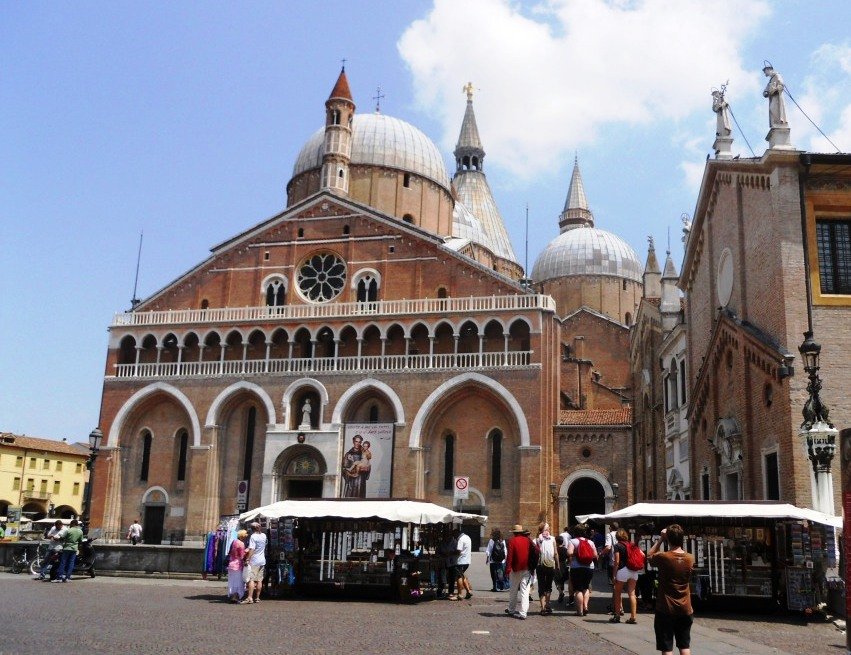
Visiting Hours, Tickets, and Historical Insights of Oratorio di San Giorgio, Padua
Date of Visit: 01/08/2024
Introduction to Oratorio di San Giorgio
Nestled in the historic city of Padua, Italy, the Oratorio di San Giorgio, or St. George’s Oratory, stands as a gothic marvel and a testament to the artistic and cultural heritage of the late 14th century. Commissioned by Raimondino Lupi of the Lupi di Soragna family in 1377, this Roman Catholic chapel was intended as a funerary chapel, reflecting the family’s deep devotion to Saint George (Arcadelsanto). The oratory is renowned for its modest exterior contrasted by a stunning interior, adorned with an extensive cycle of frescoes completed in 1384 by the celebrated artist Altichiero da Zevio, with assistance from Jacopo d’Avanzi and Sebeto da Verona (Padova). These frescoes, depicting scenes from the lives of Saint George, Saint Catherine of Alexandria, Saint Lucy, and Jesus Christ, are considered masterpieces of Gothic art and early Renaissance techniques (Wikipedia).
As a visitor, the Oratorio di San Giorgio offers a journey through history and art, with practical tips on visiting hours, ticket information, and special events. The oratory’s proximity to the Basilica di Sant’Antonio di Padova and other significant sites makes it an essential stop on any cultural tour of Padua. This guide will provide comprehensive information on the oratory’s history, architectural features, artistic significance, and visitor tips to ensure a memorable experience.
Table of Contents
- Introduction
- Origins and Purpose
- Architectural Features
- Fresco Cycle
- Visitor Information
- Historical Transformations
- Restoration Efforts
- Artistic Significance
- Travel Tips and Accessibility
- Connection to the Basilica di Sant’Antonio
- The Scoletta del Santo
- Nearby Attractions
- FAQ
- Conclusion
- Sources
Origins and Purpose
The Oratorio di San Giorgio, also known as St. George’s Oratory, is a Gothic-style Roman Catholic chapel located in Padua, Veneto, Italy. The construction of this oratory began in 1377, initiated by Raimondino Lupi, a member of the Lupi di Soragna family. The primary purpose of the oratory was to serve as a funerary chapel for the Lupi family, reflecting their deep devotion to Saint George and their desire to establish a lasting presence in the city of Padua (Arcadelsanto).
Architectural Features
The Oratorio di San Giorgio was designed as a free-standing structure, distinct from the nearby Basilica di Sant’Antonio di Padova. The facade of the oratory is relatively simple, adorned with a stone relief depicting Saint George and some thin pillars, with minimal additional decorations (Renato Prosciutto). The interior, however, is a stark contrast to the modest exterior, featuring an extensive cycle of frescoes that cover the walls and ceiling.
Fresco Cycle
The interior walls of the oratory are lined with twenty-two narrative frescoes, commissioned by Raimondino Lupi. These frescoes depict scenes from the lives of Saint George, Saint Catherine of Alexandria, Saint Lucy, and Jesus Christ. The altar wall prominently displays the Crucifixion, while the barrel-vaulted ceiling is decorated with stars (Wikipedia).
The fresco cycle was completed in 1384 by the renowned artist Altichiero da Zevio, with assistance from Jacopo d’Avanzi and Sebeto da Verona. Altichiero’s work in the oratory is considered a masterpiece of Gothic art, showcasing his innovative use of perspective and narrative storytelling (Padova).
Visitor Information
Oratorio di San Giorgio Visiting Hours
The chapel is generally open to visitors from 9 AM to 7 PM, but it is advisable to check the official website for updated hours.
Oratorio di San Giorgio Tickets
Entrance fees are typically modest, around €3 for adults. Discounts are often available for students, seniors, and groups.
Guided Tours and Special Events
Guided tours can be arranged through local tour operators or directly at the site. Special events, such as classical music concerts and art exhibitions, are occasionally hosted in the oratory.
Historical Transformations
Throughout its history, the Oratorio di San Giorgio has undergone several transformations. During the Napoleonic Wars, the frescoes were whitewashed to protect them from damage. They remained hidden until their rediscovery in 1837. Despite the passage of time and various historical events, many of the frescoes have survived, although some have suffered damage (Everything Explained).
In the late 18th century, the oratory was repurposed as a prison, which further contributed to the wear and tear of the interior decorations. However, the frescoes on the interior wall of the facade, depicting Biblical scenes such as the “Adoration of the Three Wise Men” and the “Adoration of the Shepherds,” have remained relatively well-preserved (Renato Prosciutto).
Restoration Efforts
The frescoes underwent significant restoration between 1995 and 1997 to preserve their historical and artistic value. These efforts were crucial in maintaining the integrity of Altichiero’s work and ensuring that future generations could appreciate the oratory’s artistic heritage (Arcadelsanto).
Artistic Significance
Altichiero da Zevio’s frescoes in the Oratorio di San Giorgio are not only an homage to the artistic traditions of the time but also a reflection of the Lupi family’s status and influence in Padua. The frescoes exalt the warrior virtues of the Lupi family, highlighting their military and diplomatic services to the lords of the city. Altichiero’s work is considered an innovative masterpiece that anticipated the perspective techniques of the fifteenth century (Padova).
Travel Tips and Accessibility
Best Time to Visit
Spring and autumn are ideal times to visit Padua and the Oratorio di San Giorgio, when the weather is pleasant and the tourist crowds are smaller.
Accessibility
The oratory is wheelchair accessible, and assistance is available for those with mobility issues.
Photography
Visitors are generally allowed to take non-flash photography inside the oratory. The frescoes and architectural details make for excellent photographic subjects.
Connection to the Basilica di Sant’Antonio
The Oratorio di San Giorgio is located on the same plaza as the Basilica di Sant’Antonio di Padova, one of the most significant religious sites in the city. This proximity underscores the oratory’s importance within the religious and cultural landscape of Padua. The Lupi family’s connection to the Franciscan order and their support for the construction of other chapels within the basilica further emphasize their devotion and influence (Arcadelsanto).
The Scoletta del Santo
Adjacent to the Oratorio di San Giorgio is the Scoletta del Santo, a narrow building that houses a number of important artworks. The first floor of the Scoletta was constructed in 1427, and the second floor, added in 1504, became the seat of the Sala Priorale. This hall was frescoed by artists such as Girolamo del Santo, Bartolomeo Campagna, and Titian in the early 16th century (Renato Prosciutto).
Nearby Attractions
The Oratorio di San Giorgio is a true gem for those interested in local culture and history. Nearby attractions include the Orto Botanico di Padova, the Basilica di Santa Giustina, and the Scuola del Santo, making the oratory a worthwhile stop on a cultural tour of Padua (Trek Zone).
FAQ
Q: What are the visiting hours for the Oratorio di San Giorgio?
A: The oratory is typically open from 9 AM to 7 PM, but it is best to check the official website for current visiting hours.
Q: How much are tickets to visit the Oratorio di San Giorgio?
A: Tickets are usually around €3 for adults, with discounts available for students, seniors, and groups.
Q: Are guided tours available?
A: Yes, guided tours can be arranged through local tour operators or directly at the site.
Q: Is the Oratorio di San Giorgio accessible for visitors with disabilities?
A: Yes, the oratory is wheelchair accessible, and assistance is available for those with mobility issues.
Q: Can I take photographs inside the oratory?
A: Non-flash photography is generally allowed inside the oratory.
Conclusion
The Oratorio di San Giorgio stands as a remarkable example of 14th-century Italian art and architecture. Its frescoes, painted by Altichiero da Zevio, offer a rich tapestry of religious and historical narratives that continue to captivate visitors. By preserving and appreciating these works, we not only honor the artistic achievements of the past but also ensure that future generations can experience the beauty and significance of this cultural treasure. For more updates and information, download the Audiala mobile app, check out related posts, or follow us on social media.
Sources
- Arcadelsanto. (n.d.). Saint George’s Oratory. https://www.arcadelsanto.org/en/santantonio/saint-georges-oratory/
- Padova. (n.d.). Oratory of Saint George. https://www.padova.com/discover/Rr/oratory-of-saint-george
- Wikipedia. (n.d.). Oratory of San Giorgio, Padua. https://en.wikipedia.org/wiki/Oratory_of_San_Giorgio,_Padua
- Renato Prosciutto. (n.d.). San Giorgio Oratorium Padua Scoletta Santo. https://renatoprosciutto.com/san-giorgio-oratorium-padua-scoletta-santo/
- Sant’Antonio. (n.d.). Oratory of Saint George. https://www.santantonio.org/en/content/oratory-saint-george-0
- Everything Explained. (n.d.). St. George’s Oratory, Padua. https://everything.explained.today/St._George’s_Oratory,_Padua/
- Trek Zone. (n.d.). Oratorio di San Giorgio, Padua. https://trek.zone/en/italy/places/95616/oratorio-di-san-giorgio-padua
- Gathering Dreams. (n.d.). Italy Travel Tips. https://gatheringdreams.com/italy-travel-tips/
- Every Steph. (n.d.). Padua, Italy. https://www.everysteph.com/padua-italy/
